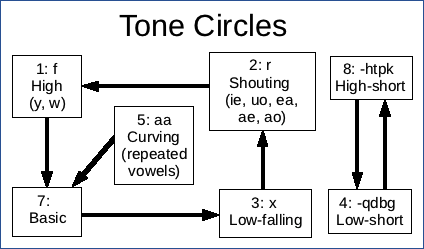Tone sandhi
Tone sandhi ("sandhi" is from the Sanskrit word for "joining") is the change of tone when certain tones are pronounced successively.
- In Taiwanese, most syllables will have to change tone depending on the surrounding words and grammatical function. The rules for this are extensive. Basically, it's a way to join syllables into words as well as to join larger units.
- Almost all verbs and adjectives will change tone to "join" them to whatever is coming next in the sentence, if present.
- The final syllable in a noun doesn't change tone, as long as it's standing alone. (If it's being used as an adjective, see above.)
Basic rules (Tone Circles)
- If the original tone number is 5 (curving-up tone), pronounce it as tone number 7 (basic).
- If the original tone number is 7 (basic tone), pronounce it as tone number 3 (low-falling).
- If the original tone number is 3 (low-falling), pronounce it as tone number 2 (shouting out).
- If the original tone number is 2 (shouting tone), pronounce it as tone number 1 (high).
- If the original tone number is 1 (high tone), pronounce it as tone number 7 (basic).
- If the original tone number is 8 (high-short), pronounce it as tone number 4 (low-short).
- If the original tone number is 4 (low-short), pronounce it as tone number 8 (high-short).
We admit this is a simplification. Please see Taiwanese Hokkien#Tone sandhi for a more detailed explanation.
Examples
- køf + hioong = Køhioong
- tvar + kao = Tvafkao
- baq + zaxng = bahzaxng
- taai + oaan = Taioaan
- bak + ciw = bagciw
Exceptions
- most nouns
- ciaf, hiaf, zef, hef, ciahniq', hiahniq'
- symmih, ui symmih, (see Taiguo_Siong'iong_460-ji#Demonstrative_pronouns)
- basic tone + ar. (The basic tone syllable is excepted).
- surnames before siensvy: Taan`siensvy
Further details
- more detailed rules have been posted at Wikipedia: Taiwanese Hokkien#Tone sandhi, esp. special cases involving suffix ar (仔) and triplication
- syllables ending in "h" are usually pronounced in shouting tone, such as in bahzaxng, but not bøeq
- khix ("to go") is usually treated as if originally "khiq"
